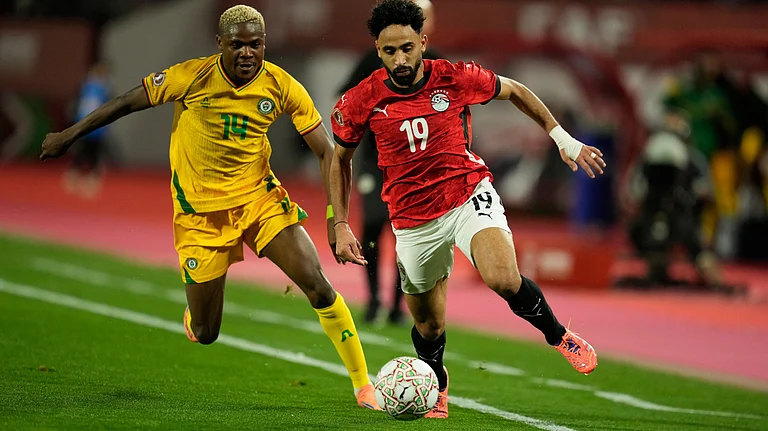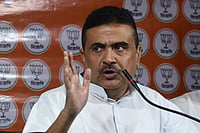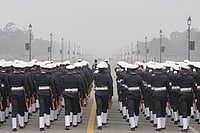IN Indias newest sunrise industry, it is darkness at dawn. Hemmed inby a complicated maze of warring, disorganised cable networks, proliferating productionhouses bent on outdoing each other in palming off substandard software, and rapidlyintensifying market wars, players in the high-profile satellite TV channel business,especially the new ones, have discovered to their consternation that the sun is about toset on their little empires even before it has well and truly risen.
Gone is the bright daylight of certaintiesthat was how it was untila year agobrought about by an unprecedented boom. Today, dark grey areas ofconfusion and panic have crept in. So, as the realisation dawns that the business is notas lucrative as it seemed at first, extreme caution has become the key. As globalbroadcasting giants slug it out for a piece of the action, the message to the hurriedlyerected, chance-directed indigenous channels is clear: make way or get swept away. But isanybody listening? Certainly not those whove thrown their hatsandmoneyinto the ring.
Indeed, the five-year-old satellite TV channel industry is a bubble thatis ready to burst in the faces of many badly bruised broadcasters whove jumped on tothe bandwagon in the past year. And the rubble threatens to be messy. What was itprecisely that went wrong? "Too many people got into the business without realisingwhat it implied. The impending shakeout is a natural consequence of this," says AmitKhanna of Plus Channel. "Many of the newcomers," feels Shiv Sharma, formerDoordarshan chief and consultant to the aborted Modi Carlton satellite TV project,"thought that they would start minting money the moment they came on air. Thatsimpossible. Youve got to understand that you need deep pockets and loads of patienceto survive in this business. Most of the new players did not."
"TV is entertainment-driven, not news-driven," confesses AnilDharker, formerly of Dalal Street Journals still-born India TV. "Exceptfor Sony, which is in the global entertainment business, no one else had the experience torun a channel. It was a new business opportunity and everyone wanted to get into itquickly." The wages of haste have proved to be very high indeed.
Not that the pie in the sky has actually shrunk; if anything, it hasgrown, with adspend projected to Rs 1,100 crore this year, an increase of 40 per cent overlast year. And the high growth rate is expected to be maintained till the turn of thecentur y. But far too many wannabes have jumped in at the deep end without possessing therequisite expertise and resources, and the revenue slices have got smaller, especiallybecause Doordarshan corners nearly 70 per cent of the advertising revenue. This naturallyseparates the men from the boys. "In any business, only a few can get to thetop," says Khanna, adding that those who find themselves in the red today were neverreally serious players.
In the past 12 months, nearly 15 new TV channels have been launchedamid much ballyhoo. But there have been few bangs, only deafening whimpers. Barring strayexceptionsESPN India (sports), Sony Entertainment Television (Hindi programming),ABNi (business) and Discovery (real-life entertainment)the new channels have madelittle impact. Big bucks are at stake, but the mad scramble for profits hasntyielded much fruit. Asia Television Network (ATN), which is currently off the air for thesecond time in six months but intends to return to business via hotbirdPanAmSat-4, BiTVs TVi, Dalal Street Journals India TV, NEPCGroups Hindi entertainment channel, which has wangled a transponder on Insat-2C in adesperate bid to survive, Shrishti Videocorps YES Channel and Doordarshansmuch-vaunted third channel have quickly joined the swelling ranks of also-rans. But forthe moment, most of them are hanging in there.
Dharker feels that the shakeout has come a trifle earlier thanexpected. "Given the size of the market and the number of players, it had tohappen," he says."Most channels depend on advertising revenue alone, and it hasnot been large enough to sustain so many of them." Of course, financial musclematters the most. For instance, Sony has the staying power that BiTV doe-snt, hesays, despite the latters superior programmes, admits Sony EntertainmentTelevisions CEO Arun Arora. The competition is certainly hotting up, but he thinksthe market is huge enough. He even foresees a turnover of nearly Rs 100 crore for his newchannel by the year-end.
Was it lack of foresight that did these floundering channels in? Not quite, sayindustry watchers. "Most players did not overlook the pitfalls inherent in thebusiness," notes Harish Thawani of Nimbus Television. "They merely miscalculatedthe importance of ground distribution. More than programming, cable carriage is thekey." An east Delhi cable operator who is part of the Hinduja-owned IN Networkagrees: "After all, how many channels can we accommodate? We transmit only what oursubscribers want."
Chitra Narain, former Doordarshan deputy director-general who now does freelance workfor Disney, is not surprised at the turn of events. "Its a principle oflife," she says. "If you have too much of anything, even if it is good, you gettired. If theres butter only for 10 slices of bread, you cannot spread it on a100." But the fatigue factor, which has up-ended the plans of many broadcasters, isonly one of the reasons why some players are rearranging their strategies and slowing downtheir advance into the market.
Many of the channels launched since mid-1995TVi, YES Channel andDoordarshans third channelare a drain on the resources of their promoters. Andthere are no signs of an immediate turnaround. Moreover, several proposed satellite TVprojects have either been completely shelved or indefinitely delayed. R.P. Goenkassatellite TV project, which was sold to the US cable company, United InternationalHoldings (UIH), hasnt yet materialised. The $1.8-billion joint venture betweenBritains Carlton Communications and the S.K. Modi Group has fallen through becausethe latter allegedly failed to meet its financial commitments, which are said to havetranslated into Rs 90 crore. The direct-to-home (DTH) satellite channel, Indiasfirst, announced by a company called Global Internet last September has yet to get off theground. Industrialist Harsh Goenka saw the writing on the wall before too much damage wasdone: he aborted his plans to get into the satellite TV business after spending about Rs60 lakh and acquiring a transponder.
Home Television (HTV), a general Hindi entertainment channel to belaunched by TV India, a joint venture involving The Hindustan Times, UKsPearson group, Hong Kongs Television Broadcasters (TVB) and Carlton, has been ingestation far longer than originally envisaged. To begin with, HTV was looking for atransponder on the Indonesian satellite Palapa C1, but is now negotiating with the ownersof PanAmSat-4 because it wants to get on to a stronger platform. The channel is alreadysix months overdue. "Its better for the sinking players to shut shop,"says Thawani. "If you do not have sufficient marketshare for a brand, the best thingto do is to kill it. The only thing thats probably keeping these channels afloat iscorporate ego."
Clearly, the unbridled exuberance that was in evidence in thesatellite TV industry a couple of years ago has been replaced by dour circumspection, ifnot scepticism. Some foreign broadcastersUIH, Time-Warners HBO, ViacomsNickleodeon and Disneyare waiting and watching. Indian players who are already inthe business are groping in the dark, struggling desperately to stay afloat in a businessthat demands high investments and affords low, and rather slow, yields. "The successof Zee is a freak phenomenon," says Shiv Sharma. "In fact, even a giant networklike STAR TV has taken four years to truly establish itself."
IN fact, STAR TV, which is already into its fifth year, hasntyet broken even. This year, the channels losses are estimated to be in the vicinityof $80 million. But the network can afford to hang in there because it is owned by RupertMurdoch, who has $2 billion in the bank and can therefore borrow as much money as hewants, whenever he wants. Despite its continuing losses, STAR TV, which is looking at along-term presence in India, is going right ahead with its expansion plans. On AsiaSat-2,the new satellite which became operational last December, the network has six C-band andthree Ku-band transponders. These will be digitally compressed to yield as many as 40channels, many of them India-specific in content.
STAR, of course, is here to stay. But everyone isnt Rupert Murdoch.BiTV, which launched an omnibus channel last July with the promise to deliver asix-channel basket by early 1996, has made little progress. With the bouquet of channelsfailing to materialise, it is grappling with a severe cash crunch. To make matters worse,Jardine Fleming India, the foreign institutional investor which has a 23 per cent stake inthe network, has reportedly refused to subscribe to BiTVs Rs 70-crore debentureissue. TVi, a combination of BiTVs proposed news and prime entertainment channels,began operation last July with three news bulletins. By October, that was down to one. Andwith the American satellite Express-6 nowhere in sight yet, BiTVs woes show no signsof ending.
Facing much the same predicament is JAIN TV, which went off theair in September last year because of non-payment of dues to Russian satellite operatorIntersputnik and returned in late December via a PanAmSat-4 transponder leased fromViacom. But visibility has dipped drastically in its second coming, scuttling thecompanys plans to go public by January-end. So low is JAIN on cash that it has beenreduced to repeating old programmes as theres no money for new software. Even ATN,which has a healthy viewer ship, is struggling in the absence of sufficient advertisementsupport. Says a senior executive in the satellite TV industry: "In India, TV nevertook off, but the channels that did and suffered were JAIN, NEPC and ATN. None of them hasenough advertisements. ATN charges as little as Rs 1,000 per slot. The situation is thatbad."
But it is not the private satellite channels alone that are introuble. Doordarshan, the state-owned broadcaster, too, is in a financial mess, with itsdues being as high as Rs 120 crore. The political uncertainty created by the hawalascandal and the coming general elections hasnt helped matters as the PlanningCommission has turned a deaf ear to its entreaties for more funds. A direct fallout hasbeen the impact on DD3, which has been scrounging for funds. The situation has come tosuch a pass that Mandi House is now toying with the idea of turning DD3scommissioned programmes into sponsored ones. But will anyone sponsor shows on a channelthat is barely visible?
With the struggle for survival turning grimmer by the day,programmers have turned to the localisation formula. The relative success of Channel V hasstrengthened the channel operators faith in indigenous programming. So, Hindi andTamil shows are in great demand. But is there room for so many general Hindi entertainmentchannels? "There is," claims Sharma. "Hindi entertainment channels will dowell if advertisement grows as projected. Six to eight such channels can survive."
So, foreign programmes are increasingly being dubbed in Hindi. The only servicethat remains steadfastly English is STAR Plus. But here, too, there is a clear logic. SaysGene Swinstead, STAR TVs managing director in India: "STAR Plus is a uniquechannel. It is a window on the world for English-speaking Indians. If we put Indianlanguage programmes on the channel, it will become just another TVi or Sony. And wedont want that to happen."
With subscription revenue being extremely low, industry observers are veeringround to the view that pay channels are the only way out. The reliance on advertisementrevenue, they say, must end. It is time to switch to subscriptions as a major source ofincome although there are numerous problems that have to be sorted out on the groundbefore pay channels can actually take off.
"If a viewer can pay to watch a movie in the theatre, why would he haveproblems doing the same to watch good films on TV?" questions Thawani. "Pay TVabroad is sports and movie-driven. They have worked there, so why not here? If the WorldCup was aired only on a pay TV channel, wouldnt people have paid to see it?"
Altaf Ali Mohamed, STARs regional chief, agrees that free-to-air channelswill continue, "but top-quality, premium programming will soon be available only onpay channels". STARs new channels, which will be beamed via the newly-launchedAsiaSat-2, will be encrypted. As will ESPN, which has been conducting encryption tests.
The dream run of the satellite beams is well nigh over. Itsnow down to hard business. Only the really tough will survive. After all, its ajungle up there in the skies.


























